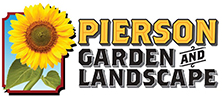


How to solve erosion problems using native plants
Our design team had three goals with this erosion project; no mowing, reduce erosion, make it look nice. Our answer for all three is the same; a no-mow “Penn Sedge”, a native groundcover plant.
NO MOW. Penn Sedge (Carex pennsylvanica, aka ‘Pennsylvania Sedge’) grows wild throughout our area. It is frequently found in the dry, dappled shade in many area woods. Penn Sedge will grow in the heavy clay soils found in Carver and Hennepin counties and flourishes when ignored forming a 6-inch tall carpet of fine light-green foliage. We at Pierson Garden and Landscape predict that Penn Sedge will increase in popularity because of its hardiness in dry shade, low-care requirements, and deer-damage resistance.
REDUCE EROSION. Three parts to our erosion plan are eliminating bare soil, slowing runoff, and catching excess runoff at an infiltration point called a “dry well”. The “Before photo” shows a large area of bare soil with patchy lawn. Bare soil is covered with a light layer of Western Red Cedar mulch as well as 1,620 Penn Sedge plants. Native plants like “Penn Sedge” will grip the soil and slow runoff that causes erosion.
Second, over 250 linear feet of drain tile, underground absorptive piping, catches runoff when the soil and plants are saturated. Drain tile catches runoff and safely delivers it to a collection point known as a dry well.
The dry well is where excess water soaks in. It greatly reduces runoff into the neighbor’s yard and eliminates runoff into streets, ponds, and lakes. The dry well we selected is called a Flo Well, an in-ground bottomless tank. When installed in the sandy soils of west Bloomington, this system handles enough runoff for 1/3 acre after heavy downpours.
Make it look nice. Drainage doesn’t have to be ugly. We designed and created a dry creek bed on the hillside using a combination of fieldstones, native plants, and hybridized plants for color to cover the drain tile and dry well. These landscape features were chosen for their low-maintenance requirements, shade tolerance, and general deer-resistance. This dry creek bed hides the drainage tiles and will visually break up the mass planting of the grass-like Penn Sedge.
Together these components eliminated mowing, reduced erosion, and improved the look and increased enjoyment of this backyard for many years.


